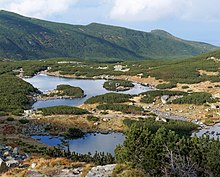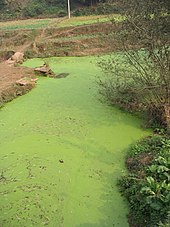Trophic state index

The Trophic State Index (TSI) is a classification system designed to rate water bodies based on the amount of
The TSI of a water body is rated on a scale from zero to one hundred.[1] Under the TSI scale, water bodies may be defined as:[1]
- oligotrophic (TSI 0–40, having the least amount of biological productivity, "good" water quality);
- mesotrophic (TSI 40–60, having a moderate level of biological productivity, "fair" water quality); or
- eutrophic to hypereutrophic (TSI 60–100, having the highest amount of biological productivity, "poor" water quality).
The quantities of
Carlson's Trophic State Index
Carlson's index was proposed by Robert Carlson in his 1977 seminal paper, "A trophic state index for lakes".[3] It is one of the more commonly used trophic indices and is the trophic index used by the United States Environmental Protection Agency.[2] The trophic state is defined as the total weight of biomass in a given water body at the time of measurement. Because they are of public concern, the Carlson index uses the algal biomass as an objective classifier of a lake or other water body's trophic status.[3] According to the US EPA, the Carlson Index should only be used with lakes that have relatively few rooted plants and non-algal turbidity sources.[2]
Index variable
Because they tend to correlate, three independent variables can be used to calculate the Carlson Index:
- where z = the depth at which the disk disappears,
- I0 is the intensity of light striking the water's surface,
- Iz is about 10% of I0 and is considered a constant,
- kw is a coefficient for the attenuation of light by water and dissolved substances,
- α is treated as a constant with the units of square meters per milligram and
- C is the concentration of particulate matter in units for milligrams per cubic meter.[3]
Trophic classifications
A lake is usually classified as being in one of three possible classes: oligotrophic, mesotrophic or eutrophic. Lakes with extreme trophic indices may also be considered hyperoligotrophic or hypereutrophic (also "hypertrophic"). The table below demonstrates how the index values translate into trophic classes.
| Trophic State Index | Chlorophyll (µg/L) | Phosphorus (µg/L) | Secchi depth (m) | Trophic Class |
|---|---|---|---|---|
| < 30—40 | 0—2.6 | 0—12 | > 8—4 | Oligotrophic or hipotrophic |
| 40—50 | 2.6—7.3 | 12—24 | 4—2 | Mesotrophic |
| 50—70 | 7.3—56 | 24—96 | 2—0.5 | Eutrophic |
| 70—100+ | 56—155+ | 96—384+ | 0.5— < 0.25 | Hypertrophic |
Oligotrophic lakes generally host very little or no
Oligotrophic

Oligotrophic lakes are most common in cold, sparsely developed regions that are underlain by crystalline
Lakes that have intermixing of their layers are classified into the category of holomictic, whereas lakes that do not have interlayer mixing are permanently stratified and thus are termed meromictic.
Generally, in a holomictic lake, during the fall, the cooling of the epilimnion reduces lake stratification, thereby allowing for mixing to occur. Winds aid in this process.[5] Thus it is the deep mixing of lakes (which occurs most often during the fall and early winter, in holomictic lakes of the monomictic subtype) that allows oxygen to be transported from the epilimnion to the hypolimnion.[6][7][8]
In this way, oligotrophic lakes can have significant
Anoxia is more common in the hypolimnion during the summer when mixing does not occur.[5] In the absence of oxygen from the epilimnion, decomposition can cause hypoxia in the hypolimnion.[9]
Mesotrophic
Mesotrophic lakes are lakes with an intermediate level of productivity. These lakes are commonly clear water lakes and ponds with beds of submerged aquatic plants and medium levels of nutrients.
The term mesotrophic is also applied to terrestrial habitats. Mesotrophic soils have moderate nutrient levels.
Eutrophic and hypertrophic
Eutrophic

A eutrophic water body, commonly a lake or pond, has high biological productivity. Due to excessive nutrients, especially nitrogen and phosphorus, these water bodies are able to support an abundance of aquatic plants. Usually, the water body will be dominated either by aquatic plants or algae. When aquatic plants dominate, the water tends to be clear. When algae dominate, the water tends to be darker. The algae engage in photosynthesis which supplies oxygen to the fish and biota which inhabit these waters. Occasionally, an excessive algal bloom will occur and can ultimately result in fish death, due to respiration by algae and bottom-living bacteria. The process of eutrophication can occur naturally and by human impact on the environment.
Eutrophic comes from the Greek eutrophos meaning "well-nourished", from eu meaning good and trephein meaning "to nourish".[10]
Hypertrophic
Hypertrophic or hypereutrophic lakes are very nutrient-rich lakes characterized by frequent and severe nuisance
The excessive algal blooms can also significantly reduce oxygen levels and prevent life from functioning at lower depths creating dead zones beneath the surface.
Likewise, large algal blooms can cause biodilution to occur, which is a decrease in the concentration of a pollutant with an increase in trophic level. This is opposed to biomagnification and is due to a decreased concentration from increased algal uptake.
Trophic index drivers
Both natural and
Freshwater lakes
Although there is no absolute consensus as to which nutrients contribute the most to increasing primary productivity, phosphorus concentration is thought to be the main limiting factor in freshwater lakes.[14][15][16] This is likely due to the prevalence of nitrogen-fixing microorganisms in these systems, which can compensate for a lack of readily available fixed nitrogen.[16]
Marine ecosystems
In some coastal marine ecosystems, research has found nitrogen to be the key limiting nutrient, driving primary production independently of phosphorus.[17][18] Nitrogen fixation cannot adequately supply these marine ecosystems, because the nitrogen fixing microbes are themselves limited by the availability of various abiotic factors like sunlight and dissolved oxygen.[19] However, marine ecosystems are too broad a range of environments for one nutrient to limit all marine primary productivity. The limiting nutrient may vary in different marine environments according to a variety of factors like depth, distance from shore, or availability of organic matter.[20][19]
Management targets
Often, the desired trophic index differs between stakeholders. Water-fowl enthusiasts (e.g. duck hunters) may want a lake to be eutrophic so that it will support a large population of waterfowl. Residents, though, may want the same lake to be oligotrophic, as this is more pleasant for swimming and boating. Natural resource agencies are generally responsible for reconciling these conflicting uses and determining what a water body's trophic index should be.
See also
- Biomass (ecology)
- Eutrophication
- Nonpoint source pollution
- Secchi disk
- Surface runoff
- Trophic level
- Trophic level index, a similar measure used in New Zealand
- Water quality
- List of biological development disorders
Notes
- ^ Note that this use of trophic levels refers to feeding dynamics, and has a much different meaning than the trophic index of water bodies.
References
- ^ a b c University of South Florida Water Institute. "Trophic State Index (TSI)". Learn More About Trophic State Index (TSI) - Lake.WaterAtlas.org. University of South Florida. Retrieved 6 June 2018.
- ^ a b c "Carlson's Trophic State Index. Aquatic Biodiversity". United States Environmental Protection Agency. 2007. Retrieved 17 February 2008.
- ^ a b c Carlson, R.E. (1977) A trophic state index for lakes. Limnology and Oceanography. 22:2 361–369.
- ^ a b Carlson R.E. and J. Simpson (1996) A Coordinator's Guide to Volunteer Lake Monitoring Methods. North American Lake Management Society. 96 pp.
- ^ OCLC 784140625.
- ^ ISSN 0022-1694.
- ISSN 1436-3240.
- ^ Dissolved Oxygen. Fondriest Environmental Products, access date 2024-2-14.
- S2CID 209571196.
- ^ Definition of eutrophic at dictionary.com.
- PMID 10339530.
- ISSN 1568-9883.
- PMID 28604811.
- PMID 18667696.
- S2CID 101079728.
- ^ S2CID 254079555.
- S2CID 9715466.
- ISSN 0272-7714.
- ^ S2CID 105382102.
- ISSN 1448-6059.



